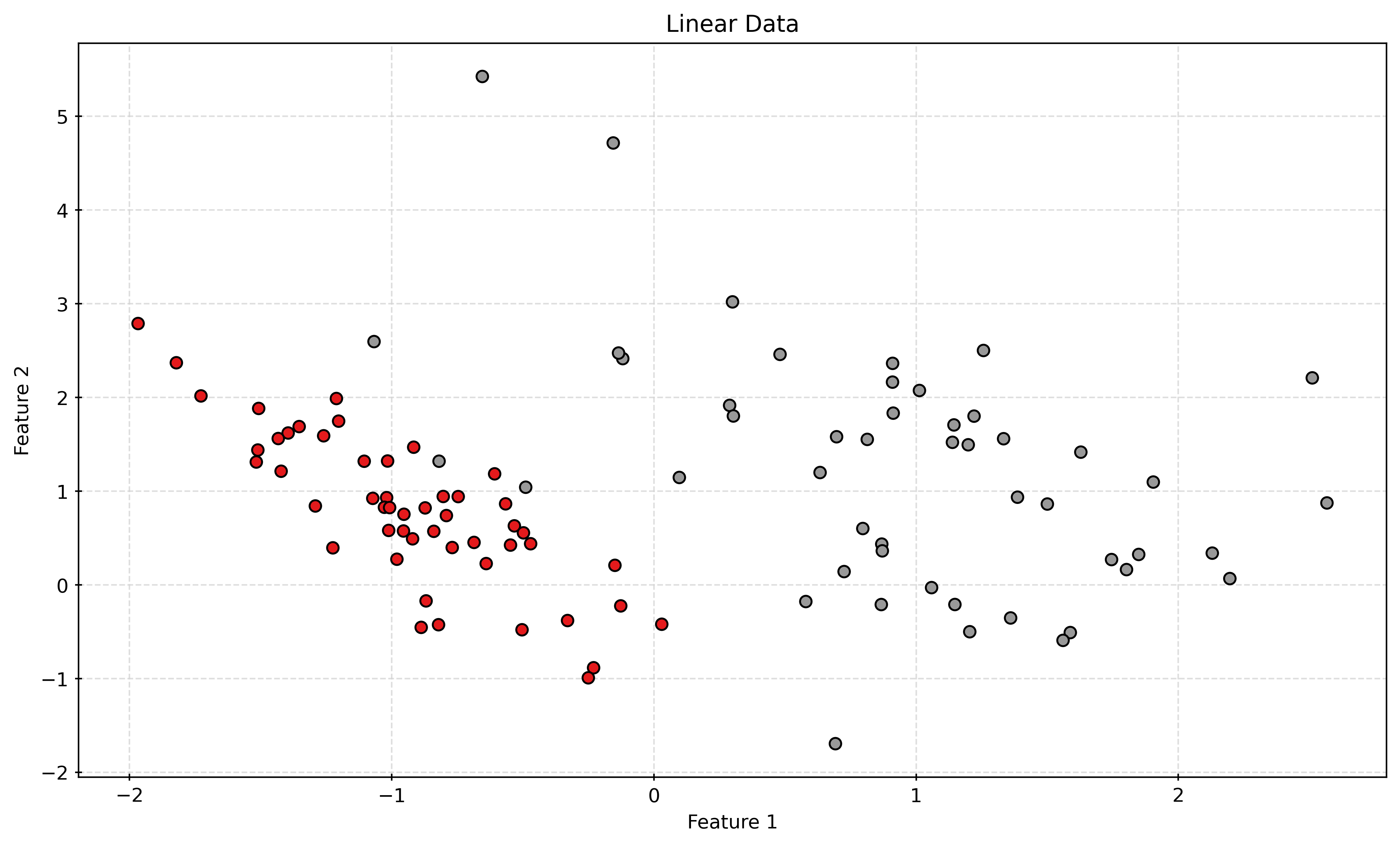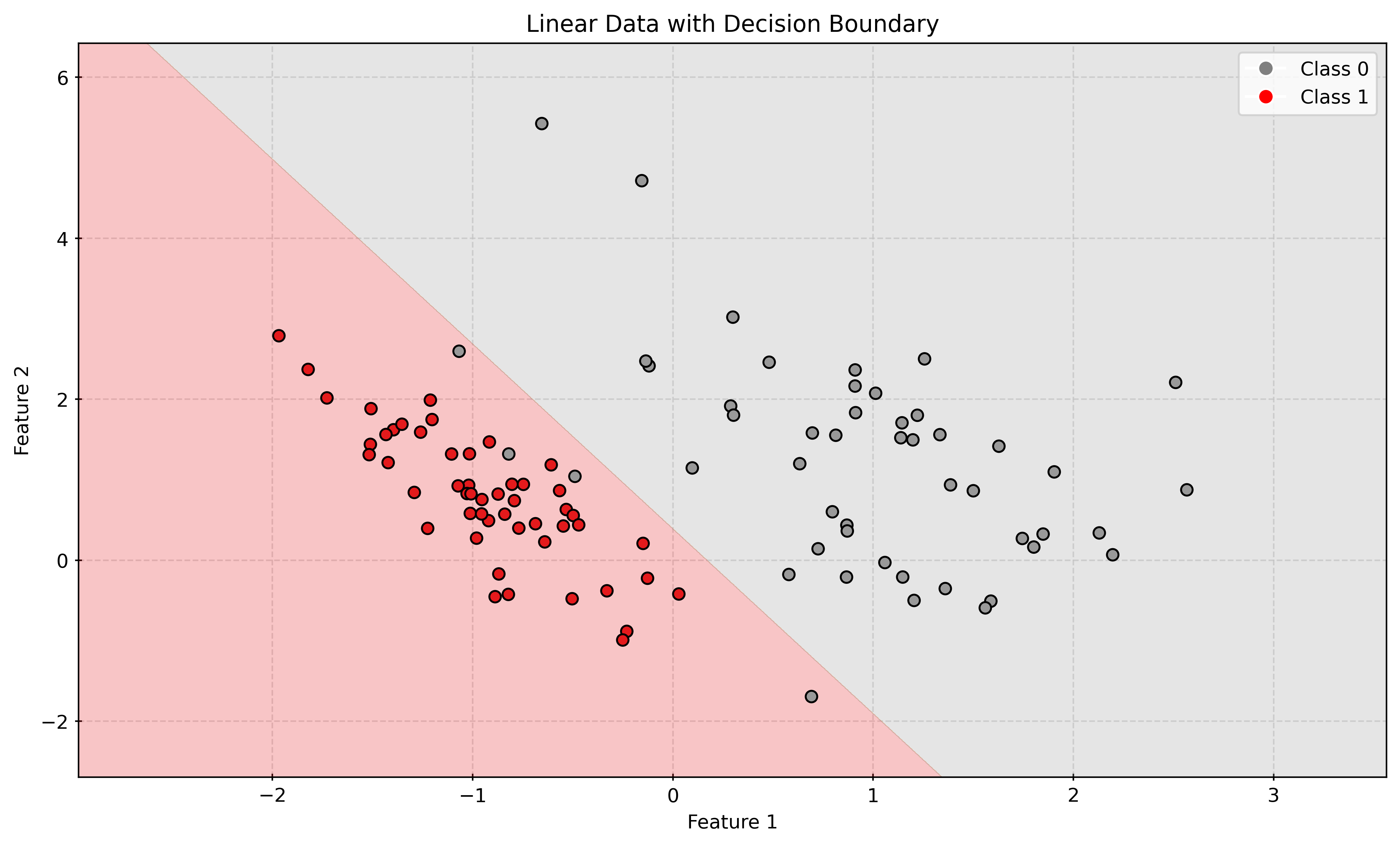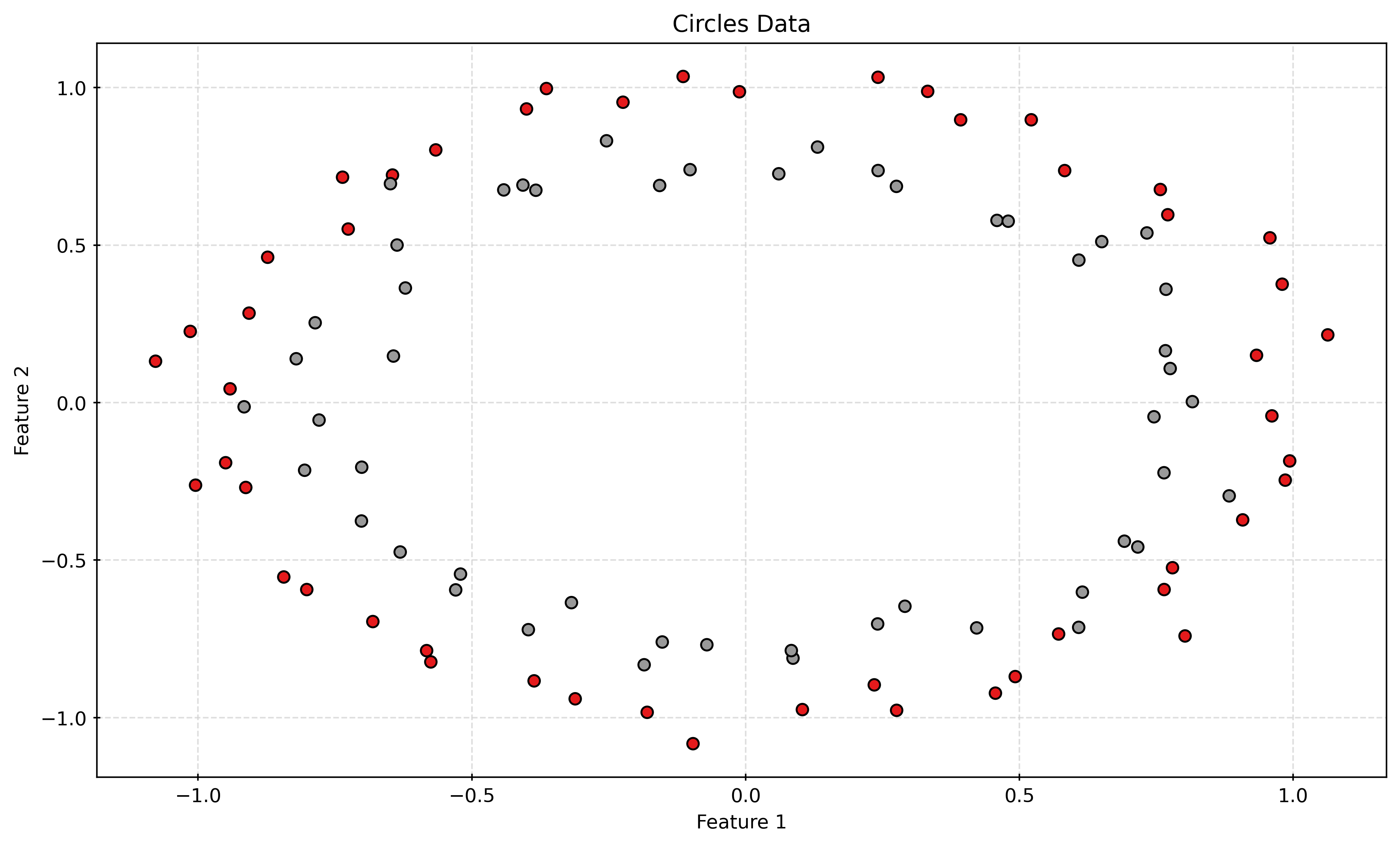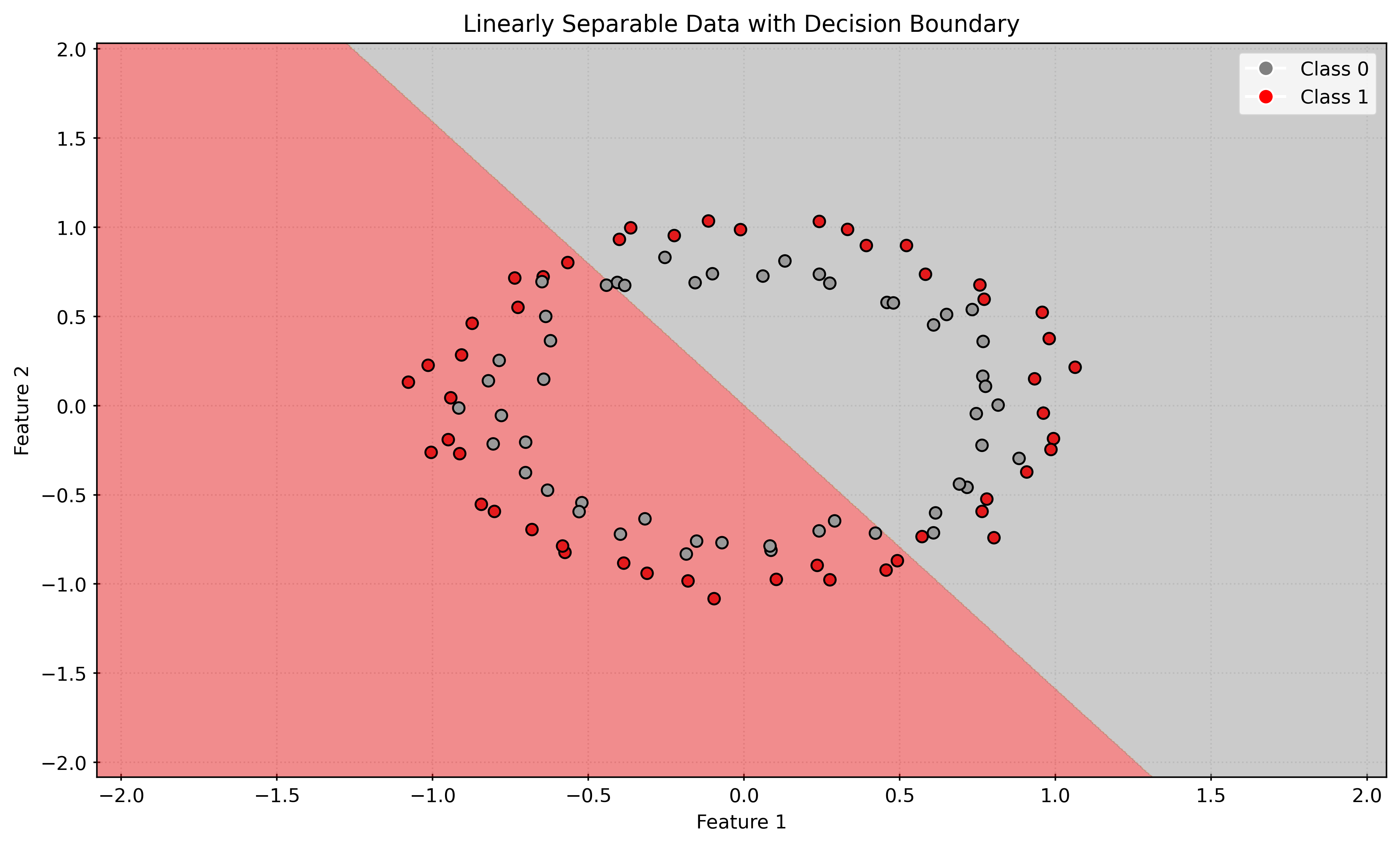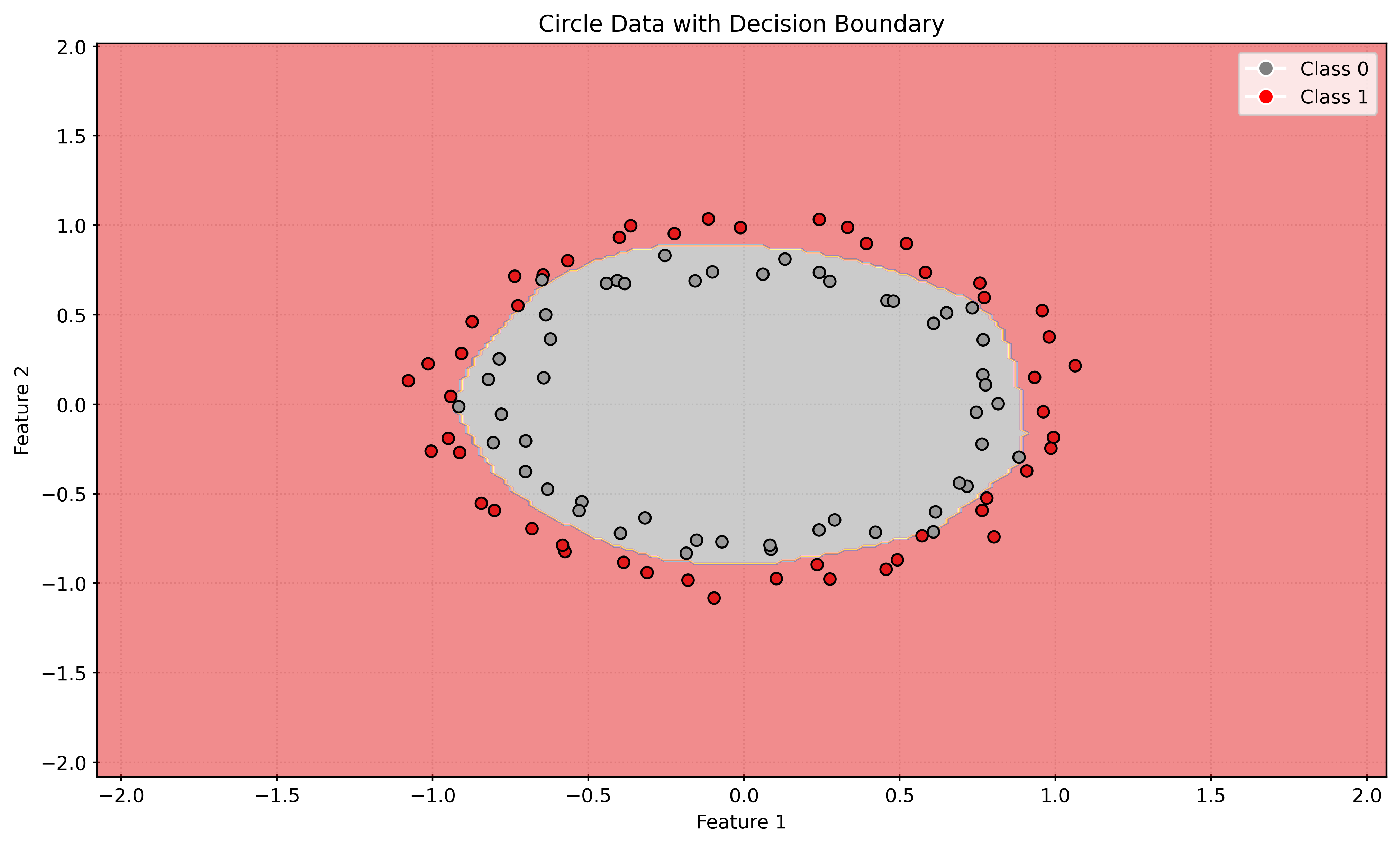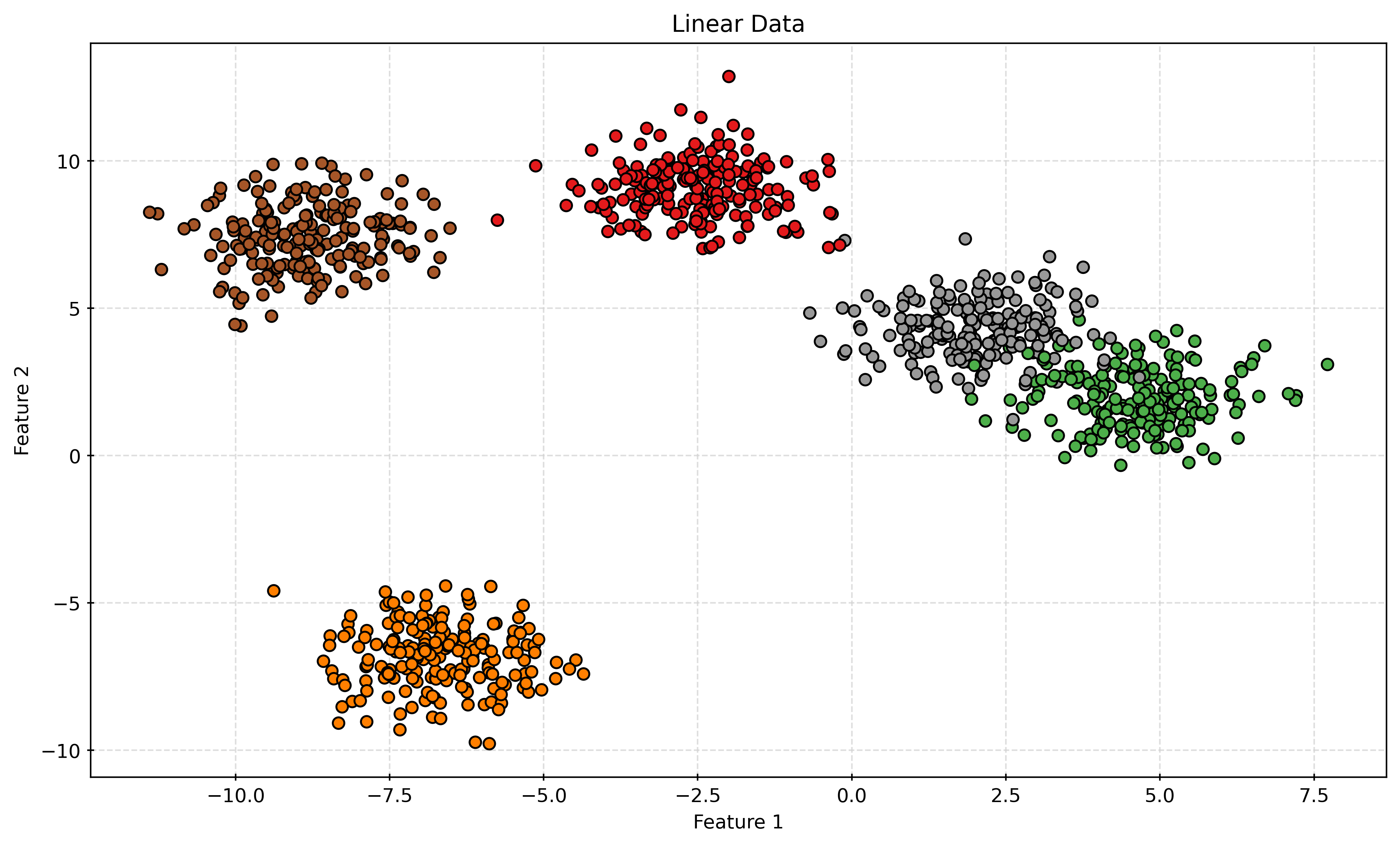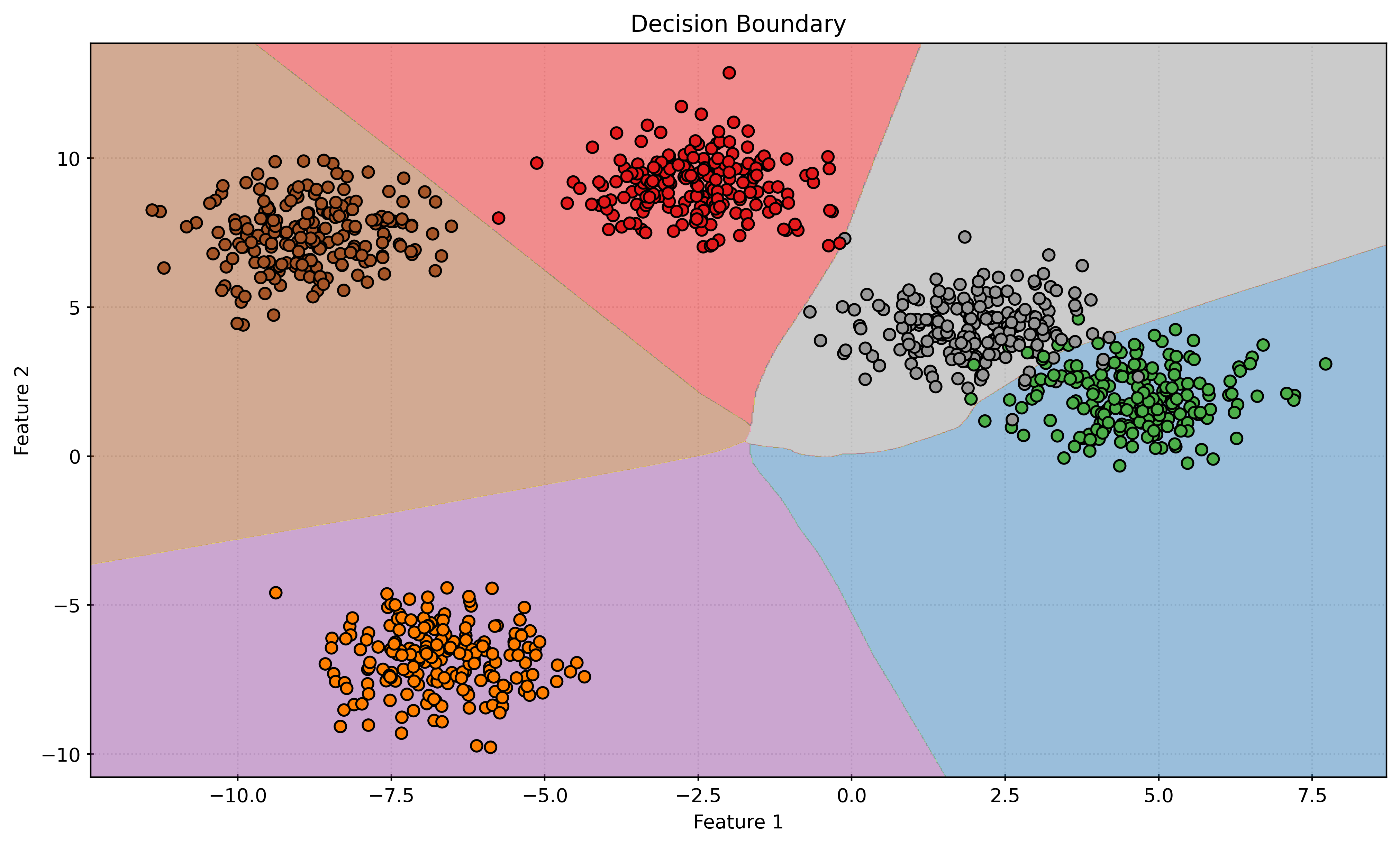# standard imports
import matplotlib.pyplot as plt
import numpy as np
import random
# sklearn data
from sklearn.datasets import make_blobs
from sklearn.datasets import make_circles
from sklearn.datasets import make_classification
from sklearn.datasets import load_digits
from sklearn.model_selection import train_test_split
# sklearn models
from sklearn.linear_model import LogisticRegression
from sklearn.ensemble import RandomForestClassifier
# sklearn metrics
from sklearn.metrics import accuracy_score
from sklearn.metrics import ConfusionMatrixDisplay
# pytorch imports
import torch
from torch import nn
from torch.utils.data import DataLoader
from torchvision import datasets
from torchvision.transforms import ToTensorNeural Networks
From Logistic Regression to Deep Learning
Torch Setup
# get cpu, gpu, or mps device for training
if torch.cuda.is_available():
device = "cuda"
elif torch.backends.mps.is_available():
device = "mps"
else:
device = "cpu"
print(f"Using {device} device!")Using mps device!If your machine does not allow for mps or cuda consider using:
- Google Colaboratory
- Be sure to change the runtime type to a GPU.
- Illinois Computes Research Notebooks
- Be sure to select the PyTorch option to utilize a GPU.
Logistic Regression as a Neural Network: Linear Data
# generate "linear" data
X, y = make_classification(
n_samples=100,
n_features=2,
n_informative=2,
n_redundant=0,
n_clusters_per_class=1,
random_state=2,
n_classes=2,
)Show Code for Plot
# create a new figure and an axes
fig, ax = plt.subplots(figsize=(10, 6))
# plot the generated data
scatter = ax.scatter(
X[:, 0],
X[:, 1],
c=y,
cmap=plt.cm.Set1,
)
# set labels and title
ax.set_xlabel("Feature 1")
ax.set_ylabel("Feature 2")
ax.set_title("Linear Data")
# add a grid
ax.grid(
color="lightgrey",
linestyle="--",
)
# display the plot
plt.show()# define a logistic regression model class
class LogisticRegressionNN(nn.Module):
def __init__(self, input_size):
super().__init__()
self.linear = nn.Linear(input_size, 1)
self.sigmoid = nn.Sigmoid()
def forward(self, x):
out = self.linear(x)
out = self.sigmoid(out)
return out# create the model instance
model = LogisticRegressionNN(X.shape[1])
print(model)LogisticRegressionNN(
(linear): Linear(in_features=2, out_features=1, bias=True)
(sigmoid): Sigmoid()
)# define the loss function
loss_fn = nn.BCELoss()
# loss_fn = nn.BCEWithLogitsLoss()
# define the optimizer
optimizer = torch.optim.Adam(
model.parameters(),
lr=0.01,
)
# convert the data to PyTorch tensors
X_tensor = torch.tensor(X, dtype=torch.float32)
y_tensor = torch.tensor(y, dtype=torch.float32)# train the model
num_epochs = 1000
for epoch in range(num_epochs):
# forward pass
outputs = model(X_tensor)
loss = loss_fn(outputs, y_tensor.view(-1, 1))
# backward and optimize
optimizer.zero_grad()
loss.backward()
optimizer.step()# print the trained model parameters
print("Trained model parameters:")
for name, param in model.named_parameters():
if param.requires_grad:
print(name, param.data)Trained model parameters:
linear.weight tensor([[3.3201, 1.4188]])
linear.bias tensor([-0.6650])# fit sklearn logistic regression
sk_model = LogisticRegression(penalty=None)
_ = sk_model.fit(X, y)# print the sklearn model parameters
sk_model.intercept_, sk_model.coef_(array([1.07315953]), array([[15.06284414, 6.71249139]]))Show Code for Plot
# generate a grid of points
x_min, x_max = X[:, 0].min() - 1, X[:, 0].max() + 1
y_min, y_max = X[:, 1].min() - 1, X[:, 1].max() + 1
xx, yy = np.meshgrid(
np.arange(x_min, x_max, 0.005),
np.arange(y_min, y_max, 0.005),
)
grid_points = np.c_[xx.ravel(), yy.ravel()]
# convert the grid points to PyTorch tensor
grid_tensor = torch.tensor(grid_points, dtype=torch.float32)
# use the trained model to predict the class labels for the grid points
with torch.no_grad():
predictions = model(grid_tensor)
labels = (predictions >= 0.5).float().numpy().reshape(xx.shape)
# create a new figure and an axes
fig, ax = plt.subplots(figsize=(10, 6))
# plot the decision boundary
ax.contourf(xx, yy, labels, alpha=0.25, cmap=plt.cm.Set1)
# plot the generated data
scatter = ax.scatter(X[:, 0], X[:, 1], c=y, cmap=plt.cm.Set1)
# set labels and title
ax.set_xlabel("Feature 1")
ax.set_ylabel("Feature 2")
ax.set_title("Linear Data with Decision Boundary")
# add a legend
legend_elements = [
plt.Line2D(
[0],
[0],
marker="o",
color="w",
label="Class 0",
markerfacecolor="grey",
markersize=8,
),
plt.Line2D(
[0],
[0],
marker="o",
color="w",
label="Class 1",
markerfacecolor="r",
markersize=8,
),
]
ax.legend(handles=legend_elements)
# add a grid
ax.grid(color="lightgrey", linestyle="--")
# display the plot
plt.show()Logistic Regression as a Neural Network: Circle Data
# generate circles data
X, y = make_circles(
n_samples=100,
noise=0.05,
random_state=42,
)
# plot the generated data
fig, ax = plt.subplots(figsize=(10, 6))
scatter = ax.scatter(
X[:, 0],
X[:, 1],
c=y,
cmap=plt.cm.Set1,
)
ax.set_xlabel("Feature 1")
ax.set_ylabel("Feature 2")
ax.set_title("Circles Data")
ax.grid(color="lightgrey", linestyle="--")
plt.show()# create the model instance
model = LogisticRegressionNN(X.shape[1])
print(model)
# define the loss function
criterion = nn.BCELoss()
# define the optimizer
optimizer = torch.optim.Adam(
model.parameters(),
lr=0.01,
)
# convert the data to PyTorch tensors
X_tensor = torch.tensor(X, dtype=torch.float32)
y_tensor = torch.tensor(y, dtype=torch.float32)
# train the model
num_epochs = 1000
for epoch in range(num_epochs):
# forward pass
outputs = model(X_tensor)
loss = criterion(outputs, y_tensor.view(-1, 1))
# backward and optimize
optimizer.zero_grad()
loss.backward()
optimizer.step()LogisticRegressionNN(
(linear): Linear(in_features=2, out_features=1, bias=True)
(sigmoid): Sigmoid()
)# print the trained model parameters
print("Trained model parameters:")
for name, param in model.named_parameters():
if param.requires_grad:
print(name, param.data)Trained model parameters:
linear.weight tensor([[0.0180, 0.0113]])
linear.bias tensor([-2.0649e-05])Show Code for Plot
# generate a grid of points
x_min, x_max = X[:, 0].min() - 1, X[:, 0].max() + 1
y_min, y_max = X[:, 1].min() - 1, X[:, 1].max() + 1
xx, yy = np.meshgrid(
np.arange(x_min, x_max, 0.005),
np.arange(y_min, y_max, 0.005),
)
grid_points = np.c_[xx.ravel(), yy.ravel()]
# convert the grid points to PyTorch tensor
grid_tensor = torch.tensor(grid_points, dtype=torch.float32)
# use the trained model to predict the class labels for the grid points
with torch.no_grad():
predictions = model(grid_tensor)
labels = (predictions >= 0.5).float().numpy().reshape(xx.shape)
# create a new figure and an axes
fig, ax = plt.subplots(figsize=(10, 6))
# plot the decision boundary
ax.contourf(xx, yy, labels, alpha=0.5, cmap=plt.cm.Set1)
# plot the generated data
scatter = ax.scatter(X[:, 0], X[:, 1], c=y, cmap=plt.cm.Set1)
# set labels and title
ax.set_xlabel("Feature 1")
ax.set_ylabel("Feature 2")
ax.set_title("Linearly Separable Data with Decision Boundary")
# add a legend
legend_elements = [
plt.Line2D(
[0],
[0],
marker="o",
color="w",
label="Class 0",
markerfacecolor="grey",
markersize=8,
),
plt.Line2D(
[0],
[0],
marker="o",
color="w",
label="Class 1",
markerfacecolor="r",
markersize=8,
),
]
ax.legend(handles=legend_elements)
# add a grid
ax.grid(True, color="lightgrey")
# display the plot
plt.show()Multi-Layer Neural Network: Circle Data
# define multi-layer neural network class
class MLP(nn.Module):
def __init__(self, input_size):
super().__init__()
self.linear = nn.Sequential(
nn.Linear(input_size, 100),
nn.ReLU(),
nn.Linear(100, 10),
nn.ReLU(),
nn.Linear(10, 1),
)
self.sigmoid = nn.Sigmoid()
def forward(self, x):
out = self.linear(x)
out = self.sigmoid(out)
return out# create the model instance
model = MLP(X.shape[1])
print(model)
# define the loss function
criterion = nn.BCELoss()
# define the optimizer
optimizer = torch.optim.SGD(
model.parameters(),
lr=0.1,
)
# convert the data to PyTorch tensors
X_tensor = torch.tensor(X, dtype=torch.float32)
y_tensor = torch.tensor(y, dtype=torch.float32)
# train the model
num_epochs = 1000
for epoch in range(num_epochs):
# Forward pass
outputs = model(X_tensor)
loss = criterion(outputs, y_tensor.view(-1, 1))
# Backward and optimize
optimizer.zero_grad()
loss.backward()
optimizer.step()MLP(
(linear): Sequential(
(0): Linear(in_features=2, out_features=100, bias=True)
(1): ReLU()
(2): Linear(in_features=100, out_features=10, bias=True)
(3): ReLU()
(4): Linear(in_features=10, out_features=1, bias=True)
)
(sigmoid): Sigmoid()
)# print the trained model parameters
# print("Trained model parameters:")
# for name, param in model.named_parameters():
# if param.requires_grad:
# print(name, param.data)Show Code for Plot
# generate a grid of points
x_min, x_max = X[:, 0].min() - 1, X[:, 0].max() + 1
y_min, y_max = X[:, 1].min() - 1, X[:, 1].max() + 1
xx, yy = np.meshgrid(
np.arange(x_min, x_max, 0.02),
np.arange(y_min, y_max, 0.02),
)
grid_points = np.c_[xx.ravel(), yy.ravel()]
# convert the grid points to PyTorch tensor
grid_tensor = torch.tensor(grid_points, dtype=torch.float32)
# use the trained model to predict the class labels for the grid points
with torch.no_grad():
predictions = model(grid_tensor)
labels = (predictions >= 0.5).float().numpy().reshape(xx.shape)
# create a new figure and an axes
fig, ax = plt.subplots(figsize=(10, 6))
# plot the decision boundary
ax.contourf(xx, yy, labels, alpha=0.5, cmap=plt.cm.Set1)
# plot the generated data
scatter = ax.scatter(X[:, 0], X[:, 1], c=y, cmap=plt.cm.Set1)
# set labels and title
ax.set_xlabel("Feature 1")
ax.set_ylabel("Feature 2")
ax.set_title("Circle Data with Decision Boundary")
# add a legend
legend_elements = [
plt.Line2D(
[0],
[0],
marker="o",
color="w",
label="Class 0",
markerfacecolor="grey",
markersize=8,
),
plt.Line2D(
[0],
[0],
marker="o",
color="w",
label="Class 1",
markerfacecolor="r",
markersize=8,
),
]
ax.legend(handles=legend_elements)
# add a grid
ax.grid(True, color="lightgrey")
# display the plot
plt.show()Multi-Layer Neural Network: Five Class Data
# generate the dataset
X, y = make_blobs(
n_samples=1000,
centers=5,
random_state=42,
)
# print the shape of the dataset
print("Shape of X:", X.shape)
print("Shape of y:", y.shape)Shape of X: (1000, 2)
Shape of y: (1000,)Show Code for Plot
# create a new figure and an axes
fig, ax = plt.subplots(figsize=(10, 6))
# plot the generated data
scatter = ax.scatter(
X[:, 0],
X[:, 1],
c=y,
cmap=plt.cm.Set1,
)
# set labels and title
ax.set_xlabel("Feature 1")
ax.set_ylabel("Feature 2")
ax.set_title("Linear Data")
# add a grid
ax.grid(color="lightgrey", linestyle="--")
# display the plot
plt.show()# check target data
y[:15]array([1, 1, 2, 1, 4, 2, 3, 4, 1, 4, 4, 2, 3, 2, 3])# define multi-layer neural network class
class MLP(nn.Module):
def __init__(self, input_size):
super().__init__()
self.linear = nn.Sequential(
nn.Linear(input_size, 100),
nn.ReLU(),
nn.Linear(100, 10),
nn.ReLU(),
nn.Linear(10, 10),
nn.ReLU(),
nn.Linear(10, 5),
)
def forward(self, x):
out = self.linear(x)
return out# create the model instance
input_size = X.shape[1]
model = MLP(input_size)
print(model)
# define the loss function
criterion = nn.CrossEntropyLoss()
# define the optimizer
optimizer = torch.optim.Adam(
model.parameters(),
lr=0.01,
)
# convert the data to PyTorch tensors
X_tensor = torch.tensor(X, dtype=torch.float32)
y_tensor = torch.tensor(y, dtype=torch.long)
# train the model
num_epochs = 1000
for epoch in range(num_epochs):
# forward pass
outputs = model(X_tensor)
loss = criterion(outputs, y_tensor)
# backward and optimize
optimizer.zero_grad()
loss.backward()
optimizer.step()MLP(
(linear): Sequential(
(0): Linear(in_features=2, out_features=100, bias=True)
(1): ReLU()
(2): Linear(in_features=100, out_features=10, bias=True)
(3): ReLU()
(4): Linear(in_features=10, out_features=10, bias=True)
(5): ReLU()
(6): Linear(in_features=10, out_features=5, bias=True)
)
)# print the trained model parameters
# print("Trained model parameters:")
# for name, param in model.named_parameters():
# if param.requires_grad:
# print(name, param.data)# convert the model predictions to numpy array
with torch.no_grad():
predictions = model(X_tensor)
predicted_labels = torch.argmax(predictions, dim=1).numpy()
# calculate the accuracy
accuracy = accuracy_score(y, predicted_labels)
print("Accuracy:", accuracy)Accuracy: 0.983Show Code for Plot
# generate a grid of points
x_min, x_max = X[:, 0].min() - 1, X[:, 0].max() + 1
y_min, y_max = X[:, 1].min() - 1, X[:, 1].max() + 1
xx, yy = np.meshgrid(
np.arange(x_min, x_max, 0.02),
np.arange(y_min, y_max, 0.02),
)
grid_points = np.c_[
xx.ravel(),
yy.ravel(),
]
# convert the grid points to PyTorch tensor
grid_tensor = torch.tensor(grid_points, dtype=torch.float32)
# use the trained model to predict the class labels for the grid points
with torch.no_grad():
predictions = model(grid_tensor)
labels = torch.argmax(predictions, dim=1).numpy().reshape(xx.shape)
# create a new figure and an axes
fig, ax = plt.subplots(figsize=(10, 6))
# plot the decision boundary
ax.contourf(
xx,
yy,
labels,
alpha=0.5,
cmap=plt.cm.Set1,
)
# plot the generated data
scatter = ax.scatter(
X[:, 0],
X[:, 1],
c=y,
cmap=plt.cm.Set1,
)
# set labels and title
ax.set_xlabel("Feature 1")
ax.set_ylabel("Feature 2")
ax.set_title("Decision Boundary")
# add a grid
ax.grid(True, color="lightgrey")
# display the plot
plt.show()Convolutional Neural Networks
Additional Reading and Resources
- Deep Learning with PyTorch
- Learn PyTorch for Deep Learning: Zero to Mastery
- CNN Explainer
- CS231n: Deep Learning for Computer Vision
- Bishop: Deep Learning Foundations and Concepts
- Goodfellow: Deep Learning
- MIT 6.S191 Introduction to Deep Learning
- Prince: Understanding Deep Learning
- PyTorch Lightning
- Keras
- Wikipedia: Neural Networks
